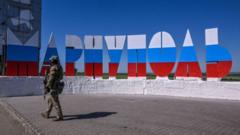The ongoing war in Ukraine has cast a long shadow over Mariupol, revealing a stark contrast between Russian portrayals of the city and the bitter truths faced by its residents. "The stories broadcasted on Russian television are nothing but fairy tales for the naive," asserts John, a local who is compelled to conceal his identity due to fear of reprisals by Russian officials. He emphasizes that while areas in downtown Mariupol are ostensibly undergoing repair for media showcasing, the surrounding neighborhoods remain plagued by devastation, with many families exposed to unsafe living conditions.
Mariupol fell to Russian forces over three years ago after a brutal siege left thousands dead and much of the city in ruins. The UN estimates that around 90% of residential buildings were harmed or obliterated during the conflict. In recent months, various pro-Russian influencers have propagated an image of the city returning to normalcy, but conversations with numerous residents paint a vastly different picture.
According to Olha Onyshko, who fled Mariupol last year, "The construction efforts are a farce. There's only reconstruction in a central square, while the remnants of homes and tragedies of the past remain unaddressed." Multimedia depictions of vibrant city life starkly clash with the testimonials of the residents, who describe persistent water shortages, unreliable power supply, and skyrocketing food prices, leaving many in dire straits.
Access to clean water is a pressing crisis, with a resident named James noting, "When water comes, it’s often tainted and undrinkable," echoing a sentiment shared by many who are forced to navigate this acute scarcity. In parallel, basic medical supplies have become a luxury that very few can afford, turning daily life into a test of endurance.
The psychological toll of occupation compounds these struggles, particularly among the youth, as the schools are now vehicles for Russian propaganda. Andrii Kozhushyna, a former university student from Mariupol, highlights the indoctrination taking place, where students are filled with false narratives about their homeland. Educational content now promotes the idea that regions integral to Ukraine’s identity are inherently Russian territory.
Amidst this bleak reality, some brave individuals engage in underground resistance, spreading messages of solidarity and resistance, clinging to the hope of liberation. James, who identifies himself as part of these groups, elaborates on their efforts to clandestinely gather intelligence about the Russian military presence in the area, highlighting the extreme dangers they face just to maintain a connection to their homeland’s sovereignty.
Explosive accounts of sabotage against military infrastructure underscore the resilience within the community, even as fear looms large in their daily lives. Residents know that even innocuous acts can lead to fatal consequences, creating an atmosphere rife with mistrust and tension.
As the tumultuous political landscape evolves, many Ukrainians in occupied Mariupol grapple with the idea of territorial concessions in peace negotiations, which some view as a betrayal of their ongoing struggles against oppression. "We refuse to accept peace at any cost," John states resolutely. "Our fight is for liberation, not merely a political agreement."
In Mariupol, the struggle for freedom continues, marked by a blend of despair and resilience as its inhabitants persevere against all odds in pursuit of a brighter future.

















